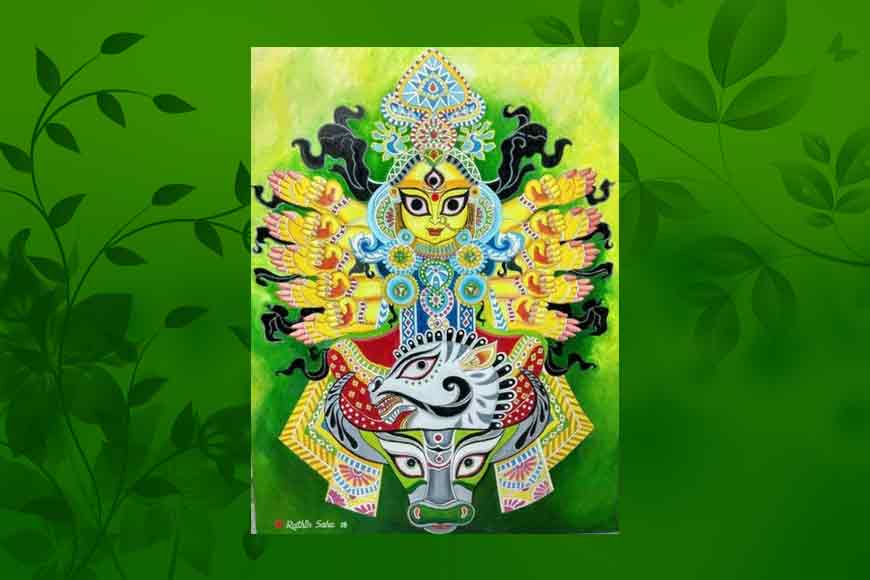How does Nature play an important role in Durga Puja

Durga Puja is not just a celebration – It is worshipping nature
“Tadeiba cha Badhishyami, Durga Makhyam Mahasuram
Durga Debiti Bikhyatam, Tasmei Nama Bhabishyati.”
Durga Puja is not just about celebrating triumph of good over evil. But it is also about celebrating and welcoming Nature. Goddess Durga’s yellow complexion signifies that the Goddess is identified as Haldi-mukhi or turmeric-faced, which makes her as radiant as the sun and connects her with all things auspicious. Durgotsav also marks the harvest season, a season of health, wealth and prosperity amidst nature
In India, the worship of Mother Goddess Durga has been in practice since the civilization of the Agrarian people. The more ancient and abstract practice of Dharitri Puja (worship of Mother Earth), which later developed into that of Mother Goddess was a notable and significant feature of the indigenous cultures of India. The earliest references can be found from Central India, which was populated by the adivasi tribes such as the Sabaras (Soras), Pulindas and Mutibas during 1 BE and 1 CE – the time when the oldest icons of Mahishamardini Durga can be traced.
Durga Puja is celebrated every year in the month of Ashwin / Sharat (September-October) and commemorates Lord Rama’s invocation of the Goddess, before his war with the demon king Ravana. This autumnal ritual was different from the conventional Durga Puja, which is usually celebrated in the spring-time. So this Puja is also known as Akal-Bodhan or ‘out-of-season’ worship. In Bengal, the festival is also observed as the arrival of daughter Uma (another name of Durga) along with her four children (Ganesh, Kartik, Lakshmi and Saraswati) to her maternal home from her heavenly abode -Kailash.
The festival of the worship of Mother Goddess – Durga, highlights the connection between Mother Nature and Mankind. The festival is correlated with clear blue skies, white fluffy clouds, bright sunshine, fields full of kash phool and Parijat/Shiuli flowers, which signals the arrival of Ashwin / Sharat and thus Sharadotsava /Durga Puja. Goddess Durga is considered as the progenitor of all the minutest and biggest things of the universe and is creator, protector and preserver of lives. The plants, the animals, the birds, the fishes, the human beings – all are her children and she provides us all the resources to live. She gives us food – therefore she is Annapurna. She protects the vegetation- therefore she is Shakambari (the herb-nourishing Goddess) – from whose body grows the life-sustaining vegetables.
In the Vedas, Goddess Durga is mentioned as “Aranyani” (The Goddess of The Forests). She is also called Bandurga (Banbibi or Byaghradevi) – the revered guardian spirit of the forests and the one who protects the forest and the wildlife. “The divinity reveals in dramatic fashion her culturo-morphic relatedness…, for her capacity as Lady of the Wild Beasts is implied in her role as Bana-Durga (Durga of the Forest), Vanaspati (Mistress of the Wood) or Bana Devi (Goddess of the Forest).” - ‘The Cult of Mother Goddess’ by E.O. James
Even the rituals of the Puja days signify presence of Nature in all its forms. Sashthi is the sixth day of Devi Pakshya that marks the formal beginning of Durga Puja. Lord Brahma had awakened the Goddess who was sleeping under a bilwa-tree (bel tree), as an eight year old girl and the leaves of the bel tree are of utmost sacrosanct for worship of Lord Shiva. The Nabapatrika ritual marks the beginning of the Durga Puja. Durga, who has been awakened and invoked in the Nabapatrika, enters the main mandap through the bringing of the Nabapatrika. This tree bride is colloquially called “Kola-Bou” / Lord Ganesh’s wife. But, in reality she has no relationship with Ganesh. Anthropologically speaking, the worship of Nabapatrika is most probably more ancient than Durgotsav itself. In ancient times, idol worship was not prevalent and hence the farmers worshipped Mother Nature for prosperous harvest. As during the autumn – the beauty of Nature is at its peak and is the time for reaping crops – the farmers worshipped Goddess Nabapatrika for good harvest. Infact, Nabapatrika represents the primitive form of Durga Puja. Later when idol worship became popular, all the nine holy rituals of the Nabapatrika worship were added to the ceremonies of Durga Puja. Other plants and flowers needed include Arum plant, halud, Jayanti plant, Dadimba (Pomegranate) plant, Ashoka tree and many more.
According to David Kinsley, a Professor of Religious Studies, “This probably signifies that the Goddess is not merely the power inherent in the growth of crops but the power inherent in all vegetation.”
One of the most important rituals of Durga Puja is the Sandhi Puja – performed during the last 24 minutes of Asthami and the first 24 minutes of Navami. This is the exact time when Goddess Durga in her Chamunda form slayed the notorious allies of Mahishashura – Chando and Munda. 108 lotus flowers are offered and 108 oil lamps are lit around the Goddess during the puja. [The number 108 connects the Sun, Moon and the Earth. The Average distance of the Sun and the Moon to Earth is 108 times their respective diameters]. Another important aspect of Sandhi puja is Balidana / Sacrifice. The Goddess is offered a sacrificial animal in this ritual in the belief that it stimulates her violent vengeance against the buffalo demon – Mahishasura. Nowadays, the animal sacrificial ritual has been abolished and instead symbolic sacrifices of vegetables like that of gourd, white pumpkin, sugarcane and cucumber are practiced.
Vahana is a creature that serves as the vehicle and sign of a particular deity in Hindu Mythology. During Durga Puja, Goddess Durga is worshipped along with Lord Shiva, Lord Ganesh, Devi Lakshmi, Devi Saraswati, Lord Kartikeya and their respective vahanas. The need to protect and conserve biological diversity is exemplified in the representation of Goddess Durga and her family. It can be observed that Goddess Durga and her entire family reflect the ecosystem. The ecosystem, in which, the carnivorous and herbivorous animals are living together harmoniously.
In the personification of Lord Shiva (Durga’s consort) we may observe the evolution of Indian traditional thought of living in partnership with Nature. Lord Shiva – with his bull mount (Nandi) represents Pashupati – Lord of Animals. Serpents coiled around his neck symbolize co-existence with the denizens of the ecosystem.
Goddess Durga is worshipped as Simhavahini - one who rides a lion. Lion is the symbol of kings and Durga is the patron deity of kings. So the worship of lion-riding Durga embodies royal power. The demon embodies the king’s enemies who have their eye on the king’s throne, known as ‘singh-asana’ or the seat of the lion. It is a reminder to the king that the Goddess who gives him royal status can abandon him, if he abandons dharma. The Lion is also an apex predator and is an indicator of the health of the ecosystem.
Photo: Author’s collection










